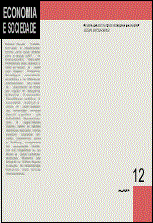Resumo
Este artigo procura demonstrar que os modelos neoclássicos de crescimento não são capazes de explicar satisfatoriamente a existência de divergências entre os países no que se refere a taxas de crescimento do nível de renda per capita, mas apenas a existência de diferenças internacionais nos níveis de renda per capita. Isso se deve ao fato de que tais modelos são, em geral, incapazes de explicar por que existem diferenças entre os países no que tange à tecnologia de produção que é empregada em cada um dos mesmos. De fato, com a possível exceção do modelo de crescimento endógeno de Romer, os modelos neoclássicos assumem que todos os países do mundo adotam a mesma tecnologia de produção; o que impossibilita a existência de taxas diferenciadas de crescimento da renda per capita.
Abstract
This article shows that neoclassical growth models are not capable to explain the existence of diverging growth rates of per capita income between countries, but only the occurrence of divergent levels of per capita income. The explanation to this lies in the fact that these models are, in general, not capable to explain why different countries employ different production technologies. In fact, with the possible exception of Romer’s endogenous growth model, neoclassical models assume that all countries employ the same technology, what makes impossible the occurrence of diverging growth rates of per capita income.
Key words: Technological progress; Capital accumulation; Endogenous growth
Referências
AGHION, P., HOWITT, P. A model of growth through creative destruction. Econometrica, v. 60, n. 2, 1992.
ARROW, K. The economic implications of learning by doing. Review of Economic Studies, Jun. 1962.
BARNETT, W. (Ed.). Equilibrium theory and applications. In: INTERNATIONAL SYMPOSIUM IN ECONOMIC THEORY AND ECONOMETRICS, 6, 1991, Cambridge. Proceedings... Cambridge: Cambridge University Press, 1991.
BARRO, R. Government spending in a simple model of endogenous growth. Journal of Political Economy, v. 98, n. 5, 1990.
DOSI, G., FABIANI, S. Convergence and divergence in long term growth of open economies. In: SILVERBERG, G., SOETE, L. The economics of growth and technical change. Aldershot: Edward Elgar, 1994.
ELLERY, R., FERREIRA, P. C. Crescimento econômico, retornos crescentes e concorrência monopolista. Revista de Economia Política, 1996.
FAGERBERG, J. A technology gap approach to why growth rates differ. Research Policy, v. 16, n. 2, 1987.
________. Why growth rates differ. In: DOSI, G. et al. (Ed.). Technical change and economic theory. London: Pinter Publishers, 1988.
________. Technology and international differences in growth rates. Journal of Economic Literature, v. 32, n. 3, 1994.
FARMER, R. A The macroeconomics of self-fulfilling prophecies. Cambridge, Mass.: MIT Press, 1993.
GROSSMAN, G., HELPMAN, E. Product development and international trade. Journal of Political Economy, v. 97, n. 6, 1989.
HARROD, R. An essay in dynamic theory. Economic Journal, Mar. 1939.
LUCAS, R. On the mechanics of economic development. Journal of Monetary Economics, v. 22, 1988.
MADDISON, A. Historia del desarrollo capitalista. Barcelona: Ariel, 1991.
MANKIW, N. G. The growth of nations. Brookings Papers on Economic Activity, 1995.
________, ROMER, D.; WEIL, D.N. A contribution to the empirics of economic growth. Quarterly Journal of Economics, n. 107, May 1992.
OBSTFELD, M., ROGOFF, K. Foundations of international macroeconomics.
Cambridge, Mass.: MIT Press, 1996.
REBELO, S. Long run policy analysis and long run growth. Journal of Political Economy, v. 99, n. 5, 1991.
ROMER, D. Advanced macroeconomics. New York: McGraw-Hill, 1996.
ROMER, P. Increasing returns and long run growth. Journal of Political Economy, v. 94, n. 5, 1986.
ROMER, P. Endogenous technological change. Journal of Political Economy, v. 98, n. 5, 1990.
________. Increasing returns and new developments in the theory of growth. In: BARNETT, W. (Ed.). Equilibrium theory and applications. In: INTERNATIONAL SYMPOSIUM IN ECONOMIC THEORY AND ECONOMETRICS, 6, 1991, Cambridge. Proceedings... Cambridge: Cambridge University Press, 1991.
SALA-I-MARTIN, X. Lecture notes on economic growth. (I): introduction to the literature and neoclassical models. Cambridge, Mass.: NBER, 1990a. (NBER Working Paper, n. 3563).
_______. Lecture notes on economic growth. (II): five prototype models of endogenous growth. Cambridge, Mass.: NBER, 1990b. (NBER Working Paper, n. 3564).
SARGENT, T. Macroeconomic theory. San Diego: Academic Press, 1987.
SILVERBERG, G., SOETE, L. The economics of growth and technical change. Aldershot: Edward Elgar, 1994.
SOLOW, R. A. Contribution to the theory of economic growth. The Quarterly Journal of Economics, v. 70, Feb. 1956.
________. Technical change and the aggregate production function. The Review of Economics and Statistics, v. 39, Aug. 1957.
________. Perspectives on growth theory. The Journal of Economic Perspectives, v. 8, n. 1, 1994.
A Economia e Sociedade utiliza a licença do Creative Commons (CC), preservando assim, a integridade dos artigos em ambiente de acesso aberto.

